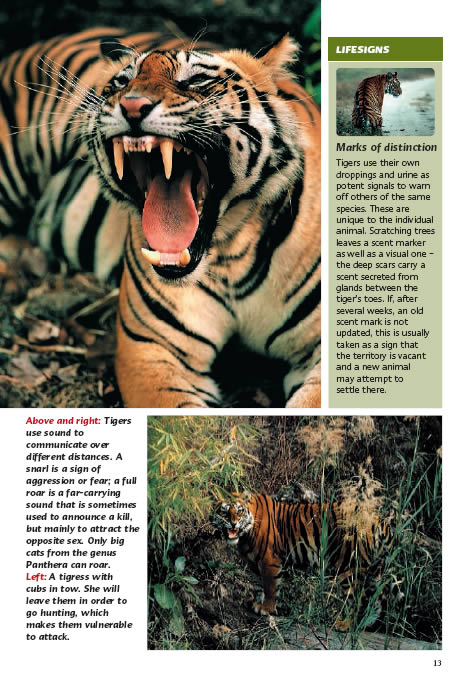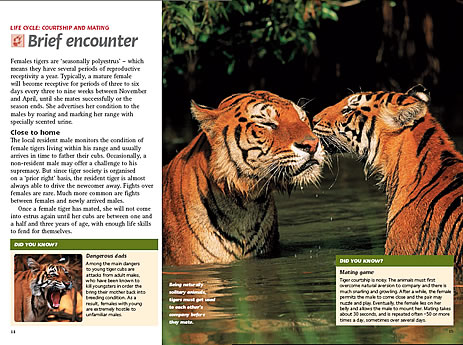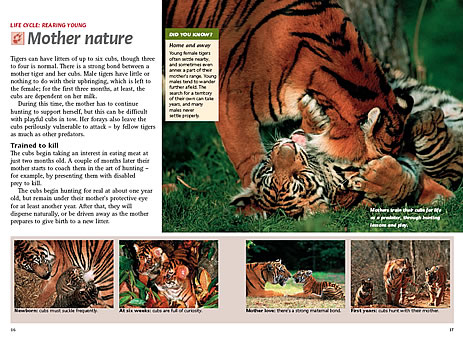LIFE CYCLE: ADULTHOOD
Separate lives
Tigers are solitary animals. Adults live alone in precisely demarcated home ranges, which tend not to overlap with those of other tigers of the same sex. For female tigers, the size of the home range depends on the quality of the habitat and availability of prey: the tigress will maintain an area large enough to supply the family's needs. Males occupy larger ranges, which usually overlap neatly with those of three of four females. This means that a large proportion of males can be left without territories. Usually these are young animals. They live a more nomadic existence, regularly passing through the ranges of resident males, but avoiding confrontation.
On their guard
Both male and female tigers regularly patrol their home range, leaving scent markers and other territorial signals. Generally these are enough to deter other tigers from attempting to move in.
Lone males
Once they reach maturity at the age of two, male tigers leave the family in search of their own territory, which they mark out with claw marks ontrees and scent from their urine. A dominant male may patrol an area of 40km2 (25 sq miles) and sire several families until old age takes its toll.


LIFESIGNS
Marks of distinction
Tigers use their own droppings and urine as potent signals to warn off others of the same species. These are unique to the individual animal. Scratching trees leaves a scent marker as well as a visual one ± the deep scars carry ascent secreted from glands between the tiger's toes. If, after several weeks, an old scent mark is not updated, this is usually taken as a sign that the territory is vacant and a new animal may attempt to settle there.
Tigers use sound to communicate over different distances. A snarl is a sign of aggression or fear; a full roar is a far-carrying sound that is sometimes used to announce a kill, but mainly to attract the opposite sex. Only big cats from the genus Panthera can roar.
A tigress with cubs in tow. She will leave them in order to go hunting, which makes them vulnerable to attack.
LIFE CYCLE: COURTSHIP AND MATING
Brief encounter
Females tigers are `seasonally polyestrus' - which means they have several periods of reproductive receptivity a year. Typically, a mature female will become receptive for periods of three to six days every three to nine weeks between November and April, until she mates successfully or the season ends. She advertises her condition to the males by roaring and marking her range with specially scented urine.
Close to home
The local resident male monitors the condition of female tigers living within his range and usually arrives in time to father their cubs. Occasionally, a non-resident male may offer a challenge to his supremacy. But since tiger society is organised on a `prior right' basis, the resident tiger is almost always able to drive the newcomer away. Fights over females are rare. Much more common are fights between females and newly arrived males. Once a female tiger has mated, she will not come into estrus again until her cubs are between one and a half and three years of age, with enough life skills to fend for themselves.
DID YOU KNOW?
Dangerous dads
Among the main dangers to young tiger cubs are attacks from adult males, who have been known to kill youngsters in order the bring their mother back intobreeding condition. As a result, females with young are extremely hostile to unfamiliar males.

Being naturally solitary animals, tigers must get used to each other's company before they mate.
DID YOU KNOW?
Mating game
Tiger courtship is noisy. The animals must first overcome natural aversion to company and there is much snarling and growling. After a while, the female permits the male to come close and the pair may nuzzle and play. Eventually, the female lies on her belly and allows the male to mount her. Mating takes about 30 seconds, and is repeated often ±50 or more times a day, sometimes over several days.
LIFE CYCLE: REARING YOUNG
Mother nature
Tigers can have litters of up to six cubs, though three to four is normal. There is a strong bond between a mother tiger and her cubs. Male tigers have little or nothing to do with their upbringing, which is left to the female; for the first three months, at least, the cubs are dependent on her milk. During this time, the mother has to continue hunting to support herself, but this can be difficult with playful cubs in tow. Her forays also leave the cubs perilously vulnerable to attack - by fellow tigers as much as other predators.
Trained to kill
The cubs begin taking an interest in eating meat at just two months old. A couple of months later their mother starts to coach them in the art of hunting ± for example, by presenting them with disabled prey to kill. The cubs begin hunting for real at about one year old, but remain under their mother's protective eye for at least another year. After that, they will disperse naturally, or be driven away as the mother prepares to give birth to a new litter.
DID YOU KNOW?
Home and away
Young female tigers often settle nearby, and sometimes even annex a part of their mother's range. Young males tend to wander further afield. The search for a territory of their own can take years, and many males never settle properly.

Newborn: cubs must suckle frequently.
At six weeks: cubs are full of curiosity.


